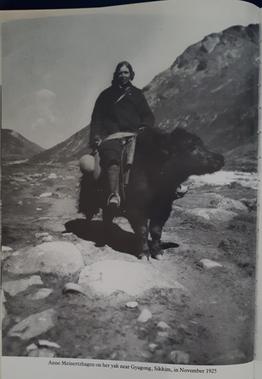Annie Meinertzhagen facts for kids
Quick facts for kids
Annie Constance Jackson
HMBOU
|
|
|---|---|
 |
|
| Born | 2 June 1889 Swordale, Ross-shire, Scotland
|
| Died | 6 July 1928 (aged 39) Swordale, Ross-shire, Scotland
|
| Cause of death | Gunshot wound |
| Education | Imperial College London |
| Spouse(s) | Richard Meinertzhagen |
| Children | 3 |
| Awards | Honorary Member of the British Ornithological Union (1915) |
| Scientific career | |
| Fields | ornithology |
| Academic advisors | Ernest MacBride |
Annie Meinertzhagen (2 June 1889 – 6 July 1928) was a Scottish ornithologist who contributed to studies on British birds, most significantly the moulting patterns in ducks and waders. She married fellow ornithologist Richard Meinertzhagen in 1921 and died from a gunshot fired under suspicious circumstances.
Contents
Early years
Born Anne Constance Jackson, her parents were Major Randle Jackson and Emily V. Baxter of Swordale, a village in eastern Ross-shire in the Scottish Highlands. Mrs Jackson was the daughter of Edward Baxter of Kincaldrum, Angus. Anne developed an early interest in natural history, especially in birds. With her younger sister Dorothy, who was to become an entomologist, she studied zoology for three years at the Imperial College of Science in London under Ernest MacBride. In 1915, she published a paper with MacBride in the Proceedings of the Royal Society on the inheritance of colour in the stick insect Carausius morosus.
Much of her early ornithological work occurred while she was based in Swordale, in Ross and Cromarty, and along the firths of Cromarty and Dornoch she began publishing papers on the local birdlife in 1909. She took an interest in bird migration and corresponded with lighthouse keepers who sent her specimens of rarities. She collected the first Scottish autumn specimens of the yellow-browed warbler and was the first ornithologist to demonstrate that the Icelandic race of the common redshank (Tringa totanus robusta) visits Britain. She often accompanied her cousin, Evelyn V. Baxter, during ornithological research.
Marriage
In March 1921, she married British soldier, intelligence officer and ornithologist Colonel Richard Meinertzhagen. She spent part of her honeymoon in research at Walter Rothschild's ornithological museum at Tring.
In the further course of her ornithological studies she travelled to Copenhagen in 1921, to Egypt and Palestine in 1923, to Madeira in 1925, and to India in the winter of 1925–26, when she joined her husband in an expedition to Sikkim and southern Tibet hunting birds and mammals in the Himalayas. She also gave birth to three children, Anne (born 1921), Daniel (born 1925) and Randle (born 1928).
Annie Constance Meinertzhagen left £113,466 (net personalty £18,733) in her will to her husband if he should remain her widower and if he re-married he was to get an annuity of £1,200 and interest in their London home for life.
Death
Annie Meinertzhagen died at her estate at Swordale on 6 July 1928, just over three months after the birth of her third child. The circumstances of her death were controversial, though no inquest or enquiry took place.
Recognition
- 1915 – Honorary Lady Member of the British Ornithologists' Union
- 1919 – Corresponding Member of the American Ornithologists' Union
She is honoured in the subspecific name of the Antipodes snipe (Coenocorypha aucklandica meinertzhagenae), described by Walter Rothschild in 1927. The subspecies Anthus cinnamomenus annae and Ammomanes deserti annae are also named in her honour.


